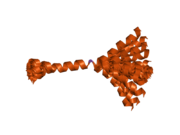TAC1
| edit |
| Tahikinin, prekurzor 1 (supstanca K, supstanca P, neurokinin 1, neurokinin 2, neuromedin L, neurokinin alfa, neuropeptid K, neuropeptid gama) | |||||||||||
|---|---|---|---|---|---|---|---|---|---|---|---|
 PDB prikaz baziran na 2b19. | |||||||||||
| Dostupne strukture | |||||||||||
| 2b19 | |||||||||||
| Identifikatori | |||||||||||
| Simboli | TAC1; Hs.2563; NK2; NKNA; TAC2 | ||||||||||
| Vanjski ID | OMIM: 162320 MGI: 98474 HomoloGene: 2394 GeneCards: TAC1 Gene | ||||||||||
| |||||||||||
| Pregled RNK izražavanja | |||||||||||
 | |||||||||||
| podaci | |||||||||||
| Ortolozi | |||||||||||
| Vrsta | Čovek | Miš | |||||||||
| Entrez | 6863 | 21333 | |||||||||
| Ensembl | ENSG00000006128 | ENSMUSG00000061762 | |||||||||
| UniProt | P20366 | Q149W7 | |||||||||
| RefSeq (mRNA) | NM_003182 | XM_984642 | |||||||||
| RefSeq (protein) | NP_003173 | XP_989736 | |||||||||
| Lokacija (UCSC) | Chr 7: 97.2 - 97.21 Mb | Chr 6: 7.51 - 7.51 Mb | |||||||||
| PubMed pretraga | [1] | [2] | |||||||||
Protahikinin-1 je protein koji je kod ljudi kodiran TAC1 genom.[1][2]
Ovaj gen kodira četiri produkta iz familije tahikininskih peptidnih hormona, supstancu P i neurokinin A, kao i srodne peptide, neuropeptid K i neuropeptid gama. Za ove hormone se smatra da funkcionišu kao neurotransmiteri koji interaguju sa nervnim receptorima i ćelijama glatkih mišića. Za njih je poznato da indukuju promene ponašanja i da dejstvuju kao vazodilatatori. Alternativno splajsovanje eksona 4 i/ili 6 proizvodi četiri poznata produkta.[2]
Reference
- ↑ Chiwakata C, Brackmann B, Hunt N, Davidoff M, Schulze W, Ivell R (May 1991). „Tachykinin (substance-P) gene expression in Leydig cells of the human and mouse testis”. Endocrinology 128 (5): 2441–8. DOI:10.1210/endo-128-5-2441. PMID 1708336.
- ↑ 2,0 2,1 „Entrez Gene: TAC1 tachykinin, precursor 1 (substance K, substance P, neurokinin 1, neurokinin 2, neuromedin L, neurokinin alpha, neuropeptide K, neuropeptide gamma)”.
Literatura
- Kowall NW, Quigley BJ, Krause JE, et al. (1993). „Substance P and substance P receptor histochemistry in human neurodegenerative diseases.”. Regul. Pept. 46 (1-2): 174–85. DOI:10.1016/0167-0115(93)90028-7. PMID 7692486.
- Advenier C, Lagente V, Boichot E (1997). „The role of tachykinin receptor antagonists in the prevention of bronchial hyperresponsiveness, airway inflammation and cough.”. Eur. Respir. J. 10 (8): 1892–906. DOI:10.1183/09031936.97.10081892. PMID 9272936.
- Rameshwar P, Oh HS, Yook C, et al. (2003). „Substance p-fibronectin-cytokine interactions in myeloproliferative disorders with bone marrow fibrosis.”. Acta Haematol. 109 (1): 1–10. DOI:10.1159/000067268. PMID 12486316.
- Saito R, Takano Y, Kamiya HO (2003). „Roles of substance P and NK(1) receptor in the brainstem in the development of emesis.”. J. Pharmacol. Sci. 91 (2): 87–94. DOI:10.1254/jphs.91.87. PMID 12686752.
- Di Angelantonio S, Giniatullin R, Costa V, et al. (2004). „Modulation of neuronal nicotinic receptor function by the neuropeptides CGRP and substance P on autonomic nerve cells.”. Br. J. Pharmacol. 139 (6): 1061–73. DOI:10.1038/sj.bjp.0705337. PMC 1573932. PMID 12871824.
- Bannon MJ, Poosch MS, Haverstick DM, et al. (1992). „Preprotachykinin gene expression in the human basal ganglia: characterization of mRNAs and pre-mRNAs produced by alternate RNA splicing.”. Brain Res. Mol. Brain Res. 12 (1-3): 225–31. DOI:10.1016/0169-328X(92)90088-S. PMID 1312203.
- McGregor GP, Conlon JM (1991). „Characterization of the C-terminal flanking peptide of human beta-preprotachykinin.”. Peptides 11 (5): 907–10. DOI:10.1016/0196-9781(90)90007-R. PMID 2284201.
- Theodorsson-Norheim E, Jörnvall H, Andersson M, et al. (1987). „Isolation and characterization of neurokinin A, neurokinin A(3-10) and neurokinin A(4-10) from a neutral water extract of a metastatic ileal carcinoid tumour.”. Eur. J. Biochem. 166 (3): 693–7. DOI:10.1111/j.1432-1033.1987.tb13567.x. PMID 3038549.
- Harmar AJ, Armstrong A, Pascall JC, et al. (1986). „cDNA sequence of human beta-preprotachykinin, the common precursor to substance P and neurokinin A.”. FEBS Lett. 208 (1): 67–72. DOI:10.1016/0014-5793(86)81534-4. PMID 3770210.
- Bhogal N, Donnelly D, Findlay JB (1994). „The ligand binding site of the neurokinin 2 receptor. Site-directed mutagenesis and identification of neurokinin A binding residues in the human neurokinin 2 receptor.”. J. Biol. Chem. 269 (44): 27269–74. PMID 7961636.
- Maruyama K, Sugano S (1994). „Oligo-capping: a simple method to replace the cap structure of eukaryotic mRNAs with oligoribonucleotides.”. Gene 138 (1-2): 171–4. DOI:10.1016/0378-1119(94)90802-8. PMID 8125298.
- Tian Y, Wu LH, Oxender DL, Chung FZ (1996). „The unpredicted high affinities of a large number of naturally occurring tachykinins for chimeric NK1/NK3 receptors suggest a role for an inhibitory domain in determining receptor specificity.”. J. Biol. Chem. 271 (34): 20250–7. DOI:10.1074/jbc.271.34.20250. PMID 8702757.
- Tanabe T, Otani H, Zeng XT, et al. (1997). „Inhibitory effects of calcitonin gene-related peptide on substance-P-induced superoxide production in human neutrophils.”. Eur. J. Pharmacol. 314 (1-2): 175–83. DOI:10.1016/S0014-2999(96)00522-5. PMID 8957234.
- Suzuki Y, Yoshitomo-Nakagawa K, Maruyama K, et al. (1997). „Construction and characterization of a full length-enriched and a 5'-end-enriched cDNA library.”. Gene 200 (1-2): 149–56. DOI:10.1016/S0378-1119(97)00411-3. PMID 9373149.
- Zimmer A, Zimmer AM, Baffi J, et al. (1998). „Hypoalgesia in mice with a targeted deletion of the tachykinin 1 gene.”. Proc. Natl. Acad. Sci. U.S.A. 95 (5): 2630–5. DOI:10.1073/pnas.95.5.2630. PMC 19441. PMID 9482938.
- Ho WZ, Lai JP, Zhu XH, et al. (1998). „Human monocytes and macrophages express substance P and neurokinin-1 receptor.”. J. Immunol. 159 (11): 5654–60. PMID 9548509.
- Lai JP, Douglas SD, Ho WZ (1998). „Human lymphocytes express substance P and its receptor.”. J. Neuroimmunol. 86 (1): 80–6. DOI:10.1016/S0165-5728(98)00025-3. PMID 9655475.
- p
- r
- u
PDB Galerija
|








